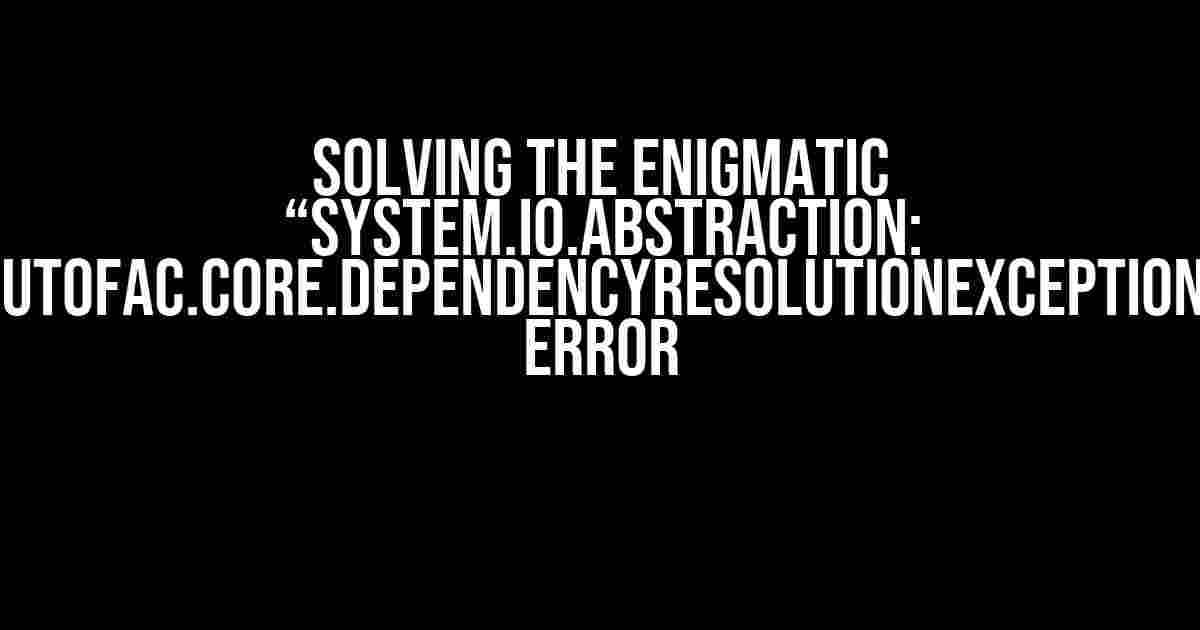Imagine this: you’re working on a critical project, and suddenly, out of the blue, you’re confronted with an error message that seems to come from nowhere. The “System.IO.Abstraction: Autofac.Core.DependencyResolutionException” error can be a frustrating and intimidating obstacle, especially for developers new to Autofac or IoC containers. Fear not, dear reader, for in this comprehensive guide, we’ll demystify this error and provide you with practical solutions to get your project back on track.
What’s behind the error?
The “System.IO.Abstraction: Autofac.Core.DependencyResolutionException” error typically occurs when Autofac, a popular Inversion of Control (IoC) container for .NET, encounters an issue while resolving dependencies for a particular component. This error can manifest in various scenarios, including:
- Incorrect or missing registrations for dependencies
- Conflicting registrations or multiple implementations for the same interface
- Misconfigured or missing modules
- Incompatible or outdated Autofac versions
Understanding the error message
The error message itself provides valuable clues about the source of the issue. Let’s break it down:
System.IO.Abstraction: Autofac.Core.DependencyResolutionException: 'An error occurred during the activation of a particular registration. See the inner exception for details.'
The error message indicates that Autofac encountered an issue while activating a specific registration, which is a critical step in resolving dependencies. The inner exception, which is not shown in the message, holds the key to understanding the root cause of the problem.
Troubleshooting the error
To tackle this error, we’ll follow a structured approach, exploring each potential cause and providing step-by-step solutions.
1. Review your registrations
Start by examining your Autofac registrations, paying attention to:
- TYPOS: Double-check for typos in your registration code, as they can lead to incorrect registrations.
- MULTIPLE REGISTRATIONS: Ensure that you’re not registering the same interface multiple times, which can cause conflicts.
- REGISTER AS: Verify that you’re registering your components correctly, using the `RegisterType` or `RegisterAssembly` methods as needed.
Here’s an example of a correct registration:
builder.RegisterType().As ();
2. Check for conflicting registrations
If you have multiple implementations for the same interface, ensure that you’re not registering them simultaneously. Instead, use Autofac’s built-in features to manage multiple implementations:
builder.RegisterType().Named ("myRepo"); builder.RegisterType ().Named ("otherRepo");
In this example, we’re using named registrations to distinguish between multiple implementations of the `IMyRepository` interface.
3. Verify module configuration
Modules are essential in Autofac, as they allow you to organize and configure your components. Ensure that:
- Your modules are correctly loaded and configured.
- You’re not missing any essential modules required by your application.
Here’s an example of loading a module:
builder.RegisterModule(new MyModule());
4. Check Autofac version compatibility
Make sure you’re using a compatible version of Autofac with your .NET framework and other dependencies. You can check the Autofac documentation for version compatibility information.
5. Inspect the inner exception
The inner exception often holds the key to resolving the issue. Catch the `DependencyResolutionException` and inspect the `InnerException` property:
try
{
// Your Autofac code here
}
catch (DependencyResolutionException ex)
{
Console.WriteLine("Inner exception: " + ex.InnerException.Message);
}
This will provide you with more detailed information about the error, helping you pinpoint the root cause.
Common gotchas and solutions
In this section, we’ll explore some common issues that can lead to the “System.IO.Abstraction: Autofac.Core.DependencyResolutionException” error.
A. Missing or incorrect assembly scanning
If you’re using Autofac’s assembly scanning feature, ensure that:
- You’ve correctly configured the assembly scanning.
- The scanned assemblies contain the necessary components.
Here’s an example of correct assembly scanning:
builder.RegisterAssemblyModules(typeof(MyModule).Assembly);
B. Incorrect usage of Autofac scopes
Autofac scopes can be tricky to manage. Make sure you’re not creating scopes unnecessarily or incorrectly:
using (var scope = container.BeginLifetimeScope())
{
// Your code here
}
C. Circular dependencies
Circular dependencies can cause Autofac to throw the “System.IO.Abstraction: Autofac.Core.DependencyResolutionException” error. To resolve this, refactor your components to avoid circular dependencies:
- Use interfaces to decouple components.
- Use Autofac’s `Owned` or `Func` features to manage dependencies.
Conclusion
The “System.IO.Abstraction: Autofac.Core.DependencyResolutionException” error can be a daunting challenge, but by following this comprehensive guide, you’ll be well-equipped to tackle it head-on. Remember to:
- Review your registrations and modules.
- Check for conflicting registrations and multiple implementations.
- Verify Autofac version compatibility.
- Inspect the inner exception for more information.
By applying these troubleshooting steps and avoiding common gotchas, you’ll be able to resolve the “System.IO.Abstraction: Autofac.Core.DependencyResolutionException” error and get your project back on track.
| Scenario | Solution |
|---|---|
| Typos in registration code | Double-check registration code for typos |
| Conflicting registrations | Use named registrations or refactor components |
| Misconfigured modules | Verify module configuration and loading |
| Incompatible Autofac version | Check Autofac version compatibility |
Don’t let the “System.IO.Abstraction: Autofac.Core.DependencyResolutionException” error hold you back. With persistence and the right guidance, you’ll overcome this obstacle and continue building exceptional software.
Frequently Asked Question
Got stuck with the infamous “System.IO.Abstraction: Autofac.Core.DependencyResolutionException: ‘An error occurred during the activation of a particular registration” error? Don’t worry, we’ve got you covered! Here are the top 5 questions and answers to help you troubleshoot and resolve this issue:
What is the “System.IO.Abstraction: Autofac.Core.DependencyResolutionException” error?
This error typically occurs when Autofac, a popular IoC container, encounters a problem while resolving dependencies. It might be due to a misconfigured registration, a circular dependency, or even a missing assembly. Don’t panic, we’ll help you identify the root cause!
What are the common causes of this error?
Some common culprits include: incorrect module registration, missing assemblies, duplicate registrations, and circular dependencies. It’s also possible that there’s a version mismatch between your Autofac and System.IO.Abstraction libraries. Take a deep breath, and let’s investigate further!
How do I troubleshoot this error?
Start by reviewing your Autofac module registrations, ensuring they’re correctly configured and version-compatible. Check for any circular dependencies, and verify that all required assemblies are present. You can also enable Autofac’s debug logging to gain more insight into the error. We’ve got some handy debugging tips to share!
Can I resolve this error by updating my Autofac or System.IO.Abstraction libraries?
Yes, updating your Autofac or System.IO.Abstraction libraries might resolve the issue, especially if you’re using an outdated version. Ensure you’re running the latest versions, and double-check for any breaking changes. However, if the error persists, there might be an underlying registration issue that needs attention.
What are some best practices to avoid this error in the future?
To avoid this error, follow best practices like registering modules explicitly, using constructor injection, and avoiding circular dependencies. Keep your Autofac modules and registrations organized, and regularly review your dependencies for any potential issues. By following these tips, you’ll be well on your way to Autofac mastery!


